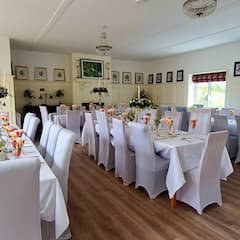His head cocked to one side listening to the distant squawking of nesting seabirds, the elusive squirrel jumped suddenly as if someone had pinched his bottom. He scratched behind his ear with his rear leg and off he scampered. Some of Britain’s wildlife is elusive, but it’s there and if you have a little patience and you visit some of the right places, the moment can be captured by anyone with a penchant for wildlife. Keep reading for an overview of some of this wildlife and where to spot it.
Red Squirrels on Brownsea Island and the Isle of Wight

Sadly, the red squirrel, although native to Britain, has suffered great losses over time due to the introduction of the larger American grey squirrel. According to the Forestry Commission there are estimated to be only 140,000 red squirrels left in Britain. Fortunately, there are a few red squirrel strongholds left in the UK including parts of Scotland, the Isle of Wight, Anglesey in Wales and Brownsea Island near Poole, Dorset.
Thriving in areas of pine woodland, they eat berries, seeds, fungi and bark. Alongside their usual eating habits, the red squirrel has a few other quirks. Apparently they can swim, although catching a photo of this happening is extremely unlikely (but would make for a great internet sensation like the monkey doing CPR). They are also, like us, either left or right handed when it comes to eating. Autumn is cited as the best time to see them and the places where I have been most successful with sightings have been Brownsea Island and the Isle of Wight.
Accessible only by ferry from Poole Quay, Brownsea is a nature lover’s mecca. Shared between the National Trust and the Dorset Wildlife Trust, it is the largest of the islands in Poole Harbour, although it is only 1.5 miles in length (2.5 km) and can easily be walked in a day if you are moderately fit. Along with the red squirrel, it’s also home to quite a few peacocks, many sea birds, and the non-native Sika deer who has strayed all the way from East Asia to make Brownsea it’s country retreat. If you are interested in history then there’s also a lot to learn about Brownsea dating back to its first inhabitants in the 9th century. Keep your eyes peeled in the pinewood areas and expect the unexpected. While meandering on the boardwalk that takes you to the nature reserve, a squirrel began strutting its stuff along the boards like some mini model. We all froze and let him wander around us as he foraged for ten minutes or more. More blatant than that was the red squirrel hanging ‘Mission Impossible’ style on the bird feeder outside the Villa, which is a beautiful 1850s vicarage tucked in the trees in the nature reserve.
The Isle of Wight, quite a bit larger in size than Brownsea, being 24 miles (39 km) in length, is also accessible by ferry. Here, red squirrels are also indigenous to the island and their population remains intact due to the absence of the grey squirrel. Sightings are still relatively rare but for a chance of seeing one, the hot spots include Robin Hill Country Park, Parkhurst Forest, around the Garlic Farm and Alverstone Mead nature trail. Parkhurst and Alverstone both have hides where you can shelter to watch for them. Alverston is a site of importance for nature conservation, meaning there is also the possibility of seeing some of the rarer bird species such as the kingfisher. The family friendly red squirrel trail can be cycled over two days, and passes close to the nature reserve. If you feel energetic then this will give you a greater opportunity to spot them along the way, although make sure you keep one eye on the path!
Otters in Dorset

If ever there was a creature that epitomised great British wildlife, it’s the otter. ‘Tarka the Otter’ a novel by Henry Williamson, describes the life of an otter living on a river in Devon. The name ‘Tarka’ is still in use today and the book remains in print having been first published back in 1927. These enigmatic creatures are making a comeback after nearly being wiped out from the UK due to pesticide poisoning, habitat destruction and conflict with humans. They are still considered a threatened species and despite being previously hunted by man, sightings have included them being captured on CCTV in Winchester town centre (doing a spot of window shopping no doubt) and in broad daylight on the river Stour in Blandford Forum, a town in Dorset.
They can have extensive territories, taking them 24 miles (40 km) along the river. Otters are mostly found in freshwater, such as rivers, but they also occupy places along the coast including the Isles of Skye, Mull and the Shetland Islands. They are, on the whole, active mainly at night, but dawn and dusk are often good times to try and catch them. If you can find their holt then you have found the pot of gold in the river, although if you do manage this, keep your distance and try not to disturb them. Local knowledge goes a long way when on their trail. It’s exciting to see a wild otter and, if you’re not a tracker, then it’s the best way to find the ideal areas to try. If there are a few otters around then you may hear their distinctive clicks, whistles and other ‘chatty’ sounds as they communicate among themselves. Also look out for bubbles on the water’s surface. Otters can hold their breath for some time and by watching a trail of bubbles, hopefully a sleek head and body will emerge at some point.
Dusk at the river Stour in Blandford Forum, near to the Stour Meadows Nature Reserve and the water is rippling down from the weir. A trail of bubbles appear from around an island in the middle of the river. There’s a sleek brown ribbon twirling in the water, then out pops a head, teeth crunching on a fish.
Deer in Richmond and Bushy Park

The two royal parks, Richmond & Bushy, are completely surrounded by a wall and gated, allowing visitors during the day but closed after dusk. These oases near the City of London are not the place you’d expect to see wild deer but they are intrinsically linked to the habitat and have been since their introduction in 1529.
Originally royal hunting grounds, red deer and fallow deer can be seen on the open grassland and among the ferns of both parks. Although they are striking on a misty autumnal morning, September until October is rutting season and the stags can be quite aggressive. Likewise, from May to July mothers are nursing their young and are best avoided. The deer act as lawnmowers to the acres of grassland within the parks and mostly you will see them grazing away from the roads that wind through them. Often the deer will find you before you find them with herds making a break for it across the tarmac at any time, so speed is limited.
Deer in the The New Forest
Another former royal hunting area, The New Forest was created in 1079 by William the Conqueror. It is, strictly speaking, not really a forest but a mixture of heath, grassland and bog, and is home to many wandering animals including ponies, pigs, cattle and deer. It covers 145 square miles (3.75 square metres), so spotting deer here may be quite challenging. Home to 5 species of deer (Sika, muntjac, fallow, roe and red) the most commonly sighted is the fallow deer but this is due to their numbers compared to the others.
The best place to spot them is the Bolderwood Deer Sanctuary where the herd are fed daily between April and September. It’s still best to take binoculars if you really want to catch a glimpse as, although they are quite habituated to the feeding times, the deer may still be situated a little way off and like anything, there’s no guarantee of seeing them. Ideally, visit on a sunny day, and when there aren’t too many crowds. Fallow deer have a beautiful speckled coat and may disappear visually in the sunlit spots of trees, although they often hang around in big herds on the open grassy areas. Keep your eye out if you are driving across the forest at night as they will often gallop across the road without warning.
You might be interested in these Airbnbs!
Dolphins and Whales in Cardigan Bay, Wales

A photo in the news recently showed a dolphin frolicking in the waters off of Brighton Pier but it’s rare enough to make it to the news so where is the best place to spot dolphins in the UK? Cardigan Bay in Wales is one of the best locations with sightings recorded daily on the Sea Watch Foundation’s website. There are two groups sighted here, one off New Quay and the other at Llangrannog. These bottlenose dolphins, generally live close to the coast. We humans have had a fascination with these beautiful and intelligent creatures for some time and it seems their affinity with us, often swimming in the wake of boats, gives them a great allure and even better PR than some of the seas other top predators. On a calm day, they can be spotted more easily and summer is the best season to see them. Cardigan Bay also plays host to grey seals and basking sharks so why not while away the hours, with your eyes out to the horizon. You never know what you’ll see.
Take only photos, leave nothing and do not disturb.
Remember even if you don’t see the wildlife, you will have experienced some of the best natural environments in the UK and had a great day out. Sadly, they aren’t called elusive, shy and rare for no reason, but you can bet your bottom dollar the creature you have been seeking is sat watching you. Let’s also not forget Scotland for being a top destination for the UK’s must see animals, including wildcat, otter, seals and the more recently reintroduced beavers. With a bit more time, I’ll definitely be making my own wildlife pilgrimages to Scotland soon.
History
Get Trip101 in your inbox
Unsubscribe in one click. See our Privacy Policy for more information on how we use your data




















Create an account to